If you think about what blue light filter fits your needs best in your progressive lenses or if you even need one this article is exactly for you.
There are several less intense blue light blocking coatings and a few more intense tints that block the blue light for you.
To really understand what I recommend and why you should know that blue light is found in the light spectrum from 380nm up to 510nm. The most intense and hazardous wavelength is 455nm. The most important wavelength for getting your sleep cycle right is 465nm – 495nm.
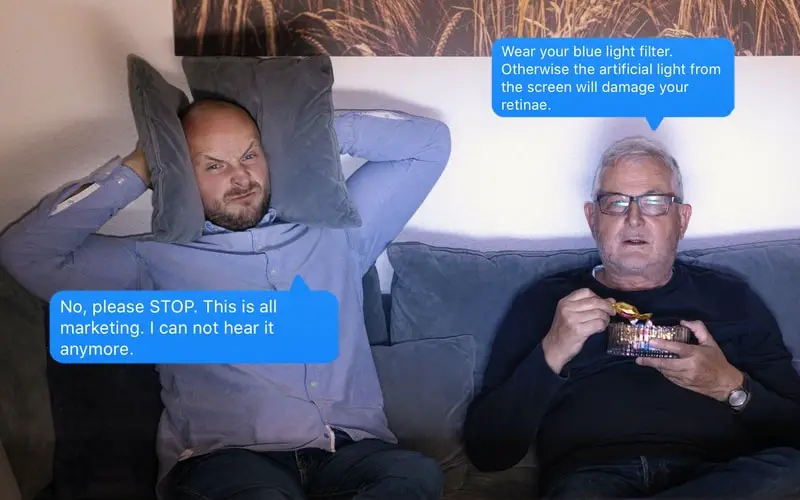
This data is important to know because most lenses out there that do reduce the exposure to blue light do not block the mentioned wavelengths but they are advertised for improving your circadian rhythm.
There are different ways on the market and we will examine them to tell you what you could choose to get the best one blue blocker for you.
What Blue Light Filter Should You Choose for Your Progressive Lenses?
Blue light filters are not created equal. Some of them work by reducing a certain peak of the light spectrum and they can be chosen if the optician talks to you about the different options in coatings. Every manufacturer filters a slightly different peak.
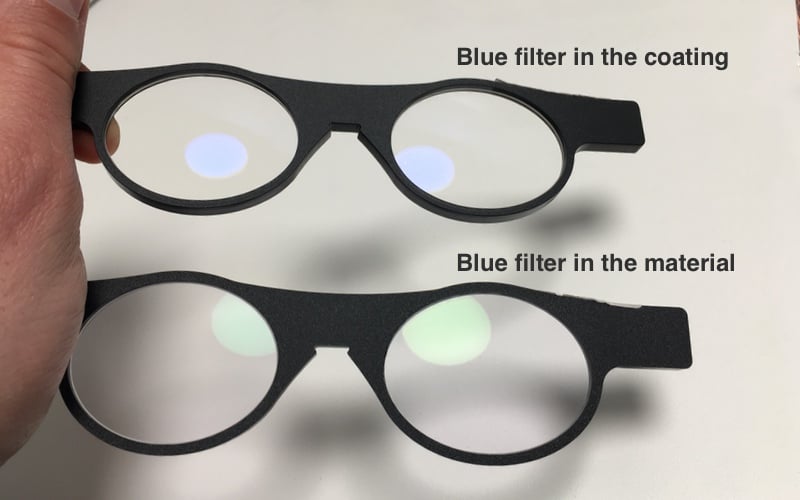
The second way to filter blue light is to choose a material with a slight tint that reduces the exposure to blue light. Those blue light filters block a whole range of wavelengths. Usually, 410nm, 420nm if they have a really minimal tint. There are even stronger blue filters out there. If you want one of them you must know that they will come with a substantial visible tint which is in orange or yellow in most cases.
But Why Would You Wear a Blue Filter in Your Progressive Lenses?
The American Academy of Ophthalmology says:
There is no scientific evidence that blue light from digital devices causes damage to your eyes.
Written By: Celia Vimont
Reviewed By: Rahul Khurana, MD
Ok, the ophthalmologists don´t recommend blue light filters in glasses. But there are also different opinions on that like from this roundtable on “ocular light toxicity and the requirement for protection“:
While it is generally agreed that there is strong molecular and functional preclinical evidence linking blue-violet light with ocular toxicity, this is yet to be shown in the clinical context.
round table
Clinical data linking blue light and age-related macular degeneration (AMD) is currently limited to epidemiologic studies.
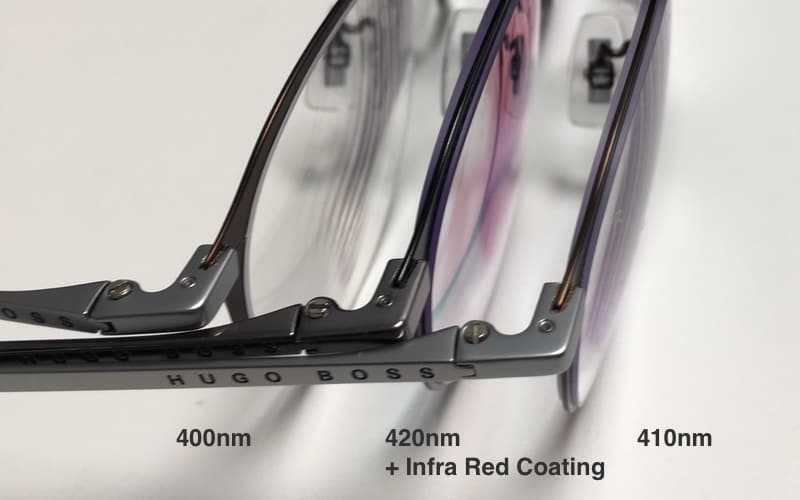
So the data that links blue light and the damage of the retina dates back to the work of John Marshall in 1972 who did his experiments with pigeons and moderate illumination. That is interesting data because of the low intensity of the illumination of the screens many consider them potentially not harmful. The intensity of the sun compared to a bright screen.
Let us talk numbers here. How bright do they shine? The sun shines with 1,6×10⁹ cd/m² and a very bright smartphone with less than 1000 cd/m².
| Sun | iPhone 11 Pro Max |
| 1.600.000.000 cd/m² | 850 cd/m² |
That is an enormous difference when it comes to exposure. Anyway if you have blue filter lenses like me. You could possibly get more protection outdoors than indoors. Think about it for one second. Screen shine on us with their LED technology with a peak in the blue light spectrum. But this peak is so unbelievably low compared to the sun. It is a joke.
But the real deal is the 420nm protection lenses (which I personally wear right now) that are advertised for protecting my eyes from digital devices. and here comes the kicker. The screens hardly permit wavelengths under 420nm anyways. Look at the pictures.
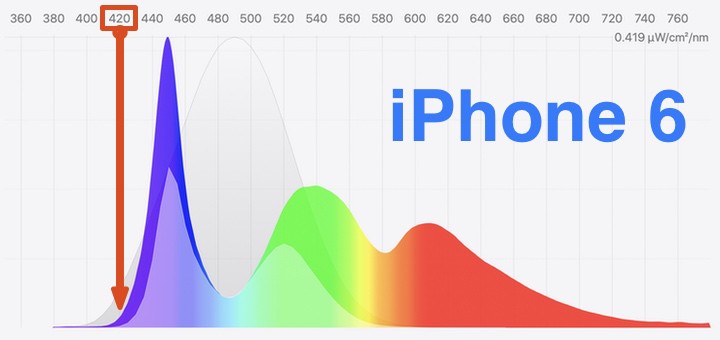
Maybe I don´t get any protection from the blue light filter when using my iPhone but at least on my other devices. Let us have a closer look at the data from a Macbook. ( you can find more insights on justgetflux.com. All credits for the pictures go to them)
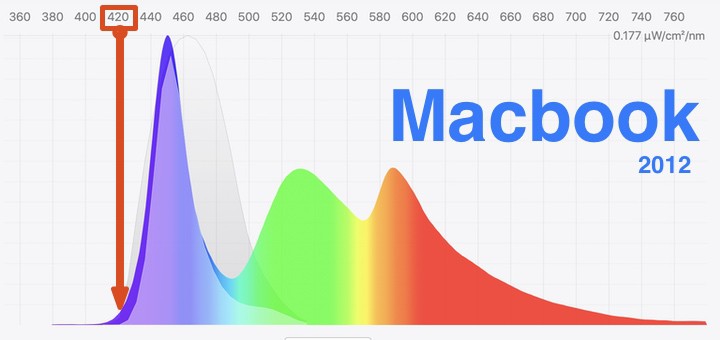
Ok and now look at how much blue light comes from the sun. The next picture shows you the spectrum and the intensity of the wavelengths if you stay outside. Please consider the sun is way more intense than every screen out there. (Of course, the distribution and the intensity varies during the course of the day).
If you compare the pictures of the light spectrums have a close look at the scaling in the upper right corner (µW/cm2). If you´d combine the light spectrum outside and from the iPhone, in one schematic you would get an extremely low spectral curve from screens compared to the light outside.
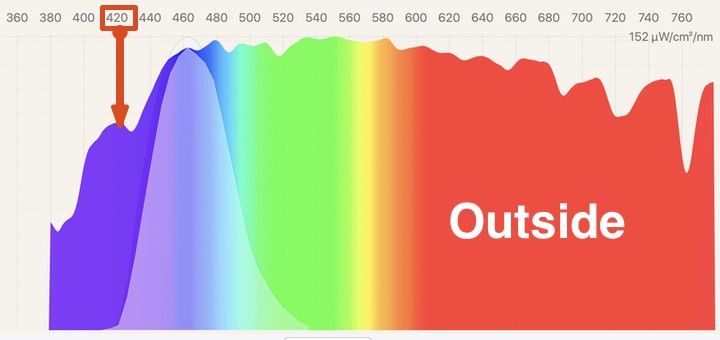
So isn´t it funny that the ophthalmic lens industry markets the lenses for enhanced protection when using digital devices? Although the biggest portion of blue light you could get is found outside.
But there are some lenses that provide even more powerful filters. An intense orange, brown or yellow tint goes along with those filters. A lot of times there are recommended when eye diseases like macular degeneration are already there.
People that work outside are definitely more exposed to blue light and are therefore at a higher risk of getting ocular damages or even diseases like macular degeneration. If you want to read more about the study done on 838 waterman click this link. So protection makes sense in the end.
But if you want the protection you will need a darker tint like found in good sunglasses. Look at how the sunglasses from Maui Jim reduce the light intensity in the spectrum in the neutral grey configuration.
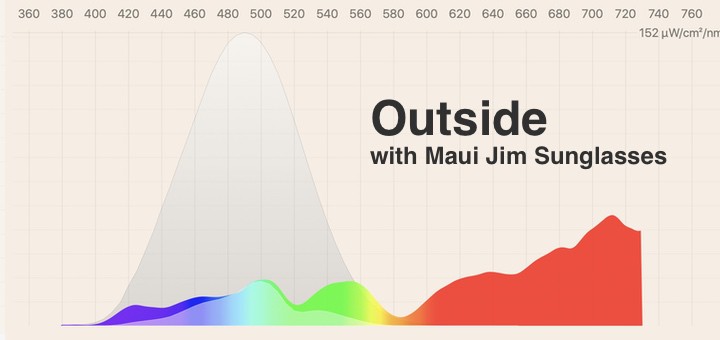
With those lenses, you are still able to see the colors in a very neutral way and get good protection. Even more protection of blue light is found on special filters made for people with diseased eyes like the wellness protect from Eschenbach.
Those lenses have special filters that could easily filter more blue light up until 470nm. But the color scheme than gets changed. The blue tones or colors you see then appear grey or black. Because they get filtered out of the light spectrum you can see. However, the rest of the colors appear just as normal as with other sunglasses.
It makes totally sense for people to protect their eyes with such an intense blue light filter but that counts for people after cataract surgery as this study from Meyer says. If you are in a group with a higher risk to develop AMD it would be a good idea to get the protection to prevent your retinae from potential photochemical damage. At least the protection does not harm your eyes.
I still wear my 420nm blue blocker in my progressive lenses writing this. And I still like them although I know the there is hardly protection added to and needed sitting in front of my MacBook.
Whom Would I Recommend the Blue Filter in Their Progressive Lenses Now?
If you like a very light tint in your progressive lenses and maybe you want to reduce the brightness of headlights at night ever so slightly then I would recommend blue filters in your progressive lenses.
How About Driving With a Blue Filter Coating?
The difference in driving at night with a blue light filter made a marginal difference to me in a small percentage of headlights from other cars. I tested this for quite some time and I guess when people describing a bigger relief with those lenses it is mostly a placebo effect. I tested a few lenses and had hardly results in minimizing dazzling.
I hope this article helps you out if you are about to buy your new lenses with or without a blue filter. Just look through them. If it feels good fine. If you don´t use them. Your eyes will be fine too. By the way, I am still wearing mine blue light filter progressive lenses. I wish you a great day.
